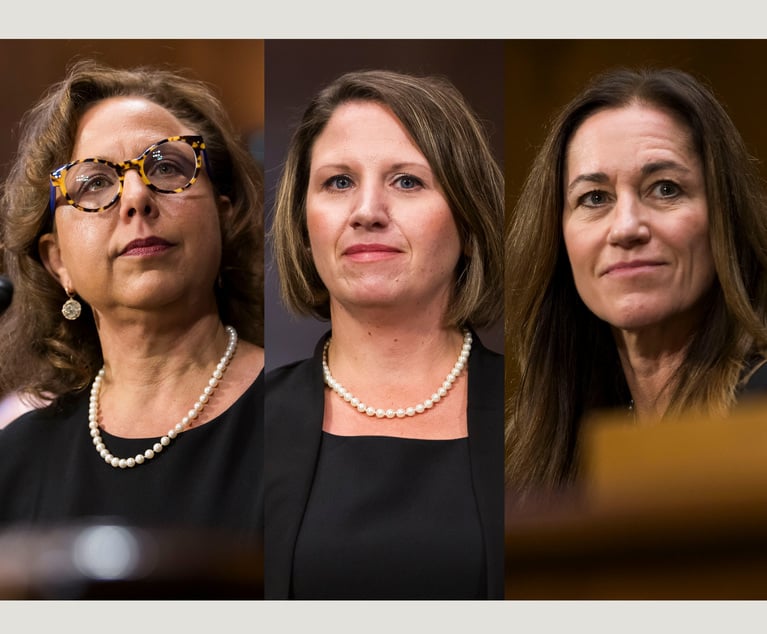Supreme Court to Address FWS Designation of Critical Habitat Under the ESA
Last week the Supreme Court granted certiorari to hear Weyerhauser v. U.S. Fish and Wildlife Service, following denial of a rehearing en banc in the Fifth Circuit Court of Appeals.
February 01, 2018 at 12:34 PM
8 minute read

Last week the Supreme Court granted certiorari to hear Weyerhauser v. U.S. Fish and Wildlife Service, following denial of a rehearing en banc in the Fifth Circuit Court of Appeals. The two issues before the court bear upon the U.S. Department of the Interior's administration of the Endangered Species Act (ESA). First, the court will consider whether the Department of the Interior, acting through the U.S. Fish and Wildlife Service (service), exceeded its regulatory authority under the ESA by designating as critical habitat certain land that has not been inhabited by the endangered species at issue for several decades and would not provide suitable habitat for the species in its present condition. Second, the court will consider whether the service's decision not to exclude land from a critical habitat designation based on the economic impact of such designation is subject to judicial review.
The Dusky Gopher Frog
The service listed the dusky gopher frog as an endangered species in 2001. The frog had historically inhabited Alabama, Louisiana and Mississippi, but by the time of listing the service had identified only one population of approximately 100 frogs in one pond in Mississippi. The service found that the species was particularly threatened by the destruction of its habitat.
When adding a species to the endangered species list, “to the maximum extent prudent and determinable” the agency “shall … designate any habitat of such species which is then considered to be critical habitat,” 16 U.S.C. Section 1533(a)(3). The designation of critical habitat is to be made “on the basis of the best scientific data available and after taking into consideration the economic impact, the impact on national security, and any other relevant impact.” The service identified three features needed to “sustain the essential life history functions of the frog: 'ephemeral' (i.e., seasonally existing) ponds necessary for the frog's breeding; upland forested nonbreeding habitat; and upland connectivity habitat between breeding and nonbreeding habitats.”
Between the time the service designated the frog endangered and when it commenced the critical habitat rulemaking, two additional small populations of frogs had been established near the initial pond in Mississippi. To account for the risk of extinction caused by the proximity of the occupied sites, the service proposed to also designate areas that were unoccupied by the frog. In the proposed rule, each of the unoccupied areas so designated were within four counties in Mississippi.
The public reviewed the service's determination during the notice and comment period, and six dusky gopher frog and conservation-biology experts conducted a peer review. The reviewers unanimously agreed that the restricted range of the initial critical habitat designation was inadequate to protect against random, localized occurrences such as drought and disease. At the panel's recommendation, the service began to “look within the species' historic range outside the state of Mississippi for additional habitat for the designation.” The service focused on identifying breeding grounds because of the “rarity” of “open-canopied, isolated, ephemeral ponds within the historic range of the dusky gopher frog.” The service discovered a site in Louisiana (the site) that the frogs last inhabited in 1965 that contained five ephemeral ponds “intact and of remarkable quality.” Although the Service noted the upland habitat in its current condition would not be suitable for the frog, it found the areas suitable for potential restoration. In June 2012, the service included the Site in its designation of critical habitat, finding it “essential for the conservation of the species.” See 16 U.S.C. Section 1532(5)(A)(ii) (defining “critical habitat” to include “specific areas outside the geographical area occupied by the species at the time it is listed … upon a determination by the Secretary that such areas are essential for the conservation of the species.).
The site is a 1,544-acre tract of land in St. Tammany Parish in Louisiana. The petitioners in this case collectively own all of the site and intend to use it for residential and commercial development and timber operations. The landowners assert two reasons the ESA prohibits the service from designating the site as critical habitat. First, to constitute “critical habitat” such area must be the species' habitat. See 16 U.S.C. Section 1533(a)(3)(A)(i) (“designate any habitat … which is then considered to be critical habitat.”). Second, in their view, the service acted arbitrarily and capriciously when it designated the Site as critical habitat because the site is neither suitable frog habitat without significant modification nor essential for the conservation of the frog.
Supported by its extensive administrative record upon which it based its critical habitat designation, the service disagrees with the landowners. According to the service, because Congress did not define the word “essential” in the ESA, a court must afford Chevron deference to the service's interpretation of the term. As such, a court's standard of review is whether the agency's action was arbitrary and capricious or based upon an unreasonable interpretation of the statute.
The service's position may cause the court to re-examine its Chevron holding. As the U.S. Court of Appeals for the Fifth Circuit explained, “where, as here, an agency's decision qualifies for Chevron deference, we will accept the agency's reasonable construction of an ambiguous statute that the agency is charged with administering,” as in Markle Interests v. U.S. Fish and Wildlife Service 827, F.3d 452, 468 (5th Cir. 2016) (citation omitted). Justice Neil Gorsuch has been a vocal opponent of Chevron deference, and this case could present an opportunity to restrict the flexibility afforded federal agencies, see Gutierrez-Brizuela v. Lynch, 834 F.3d 1142 (10th Cir. 2016) (J. Gorsuch, concurring) (“There's an elephant in the room with us today. We have studiously attempted to work our way around it an even left it unremarked. But that fact is Chevron and Brand X permit executive bureaucracies to swallow huge amount of core judicial and legislative power and concentrate federal power in a way that seems more than a little difficult to square with the Constitution of the framers' design. Maybe the time has come to face the behemoth.”).
Economic Impact
The ESA requires the service to “take into consideration the economic impact … of specifying any particular area as critical habitat.” To satisfy this obligation, the service commissioned an economic report to develop three impact scenarios. The scenarios revealed a potential economic impact ranging on the site from $0 to $33.9 million over a period of 20 years, depending on the nature of any future development plans, whether any federal approvals will be required, and, if so, any limits imposed.
The range of potential economic impact is large because a critical habitat designation does not impose any obligations directly on a private landowner. Rather, the designation imposes obligations on federal agencies to “insure that any action authorized, funded, or carried out by such agency . . . is not likely to . . . result in the destruction or adverse modification of the designated critical habitat.” If, for example, the landowners seek a permit under the Clean Water Act, the Environmental Protection Agency will need to consult with the service to determine if any restrictions are required on the permit to protect the critical habitat. Until the restrictions are known, the economic impact cannot be determined with precision.
Following consideration of economic impact, the service “may exclude any area from critical habitat if it determines that the benefits of such exclusion outweigh the benefits of specifying such area as part of the critical habitat.” The service contends that once it considers economic impact, its decision not to exclude an area is discretionary and therefore not judicially reviewable under the Administrative Procedure Act. An action is committed to agency discretion when there is no “meaningful standard against which to judge the agency's exercise of discretion,” as in Heckler v. Chaney, 470 U.S. 821, 830 (1985). The court of appeals held that “the section established a discretionary process by which the service may exclude areas from designation, but it does not articulate a standard governing when the service must exclude an area from designation.” If, on the other hand, the court is to accept the landowners' position that abuse of discretion can always provide a meaningful standard, previously unreviewable administrative decisions may become subject to judicial review.
Mark L. Greenfogel is an associate at Warren Environmental Counsel, an environmental and water resources law practice. He can be reached at [email protected].
This content has been archived. It is available through our partners, LexisNexis® and Bloomberg Law.
To view this content, please continue to their sites.
Not a Lexis Subscriber?
Subscribe Now
Not a Bloomberg Law Subscriber?
Subscribe Now
NOT FOR REPRINT
© 2025 ALM Global, LLC, All Rights Reserved. Request academic re-use from www.copyright.com. All other uses, submit a request to [email protected]. For more information visit Asset & Logo Licensing.
You Might Like
View All
Pa. Federal District Courts Reach Full Complement Following Latest Confirmation

The Defense Bar Is Feeling the Strain: Busy Med Mal Trial Schedules Might Be Phila.'s 'New Normal'
7 minute read
Federal Judge Allows Elderly Woman's Consumer Protection Suit to Proceed Against Citizens Bank
5 minute read
Judge Leaves Statute of Limitations Question in Injury Crash Suit for a Jury
4 minute readTrending Stories
- 1'A Death Sentence for TikTok'?: Litigators and Experts Weigh Impact of Potential Ban on Creators and Data Privacy
- 2Bribery Case Against Former Lt. Gov. Brian Benjamin Is Dropped
- 3‘Extremely Disturbing’: AI Firms Face Class Action by ‘Taskers’ Exposed to Traumatic Content
- 4State Appeals Court Revives BraunHagey Lawsuit Alleging $4.2M Unlawful Wire to China
- 5Invoking Trump, AG Bonta Reminds Lawyers of Duties to Noncitizens in Plea Dealing
Who Got The Work
J. Brugh Lower of Gibbons has entered an appearance for industrial equipment supplier Devco Corporation in a pending trademark infringement lawsuit. The suit, accusing the defendant of selling knock-off Graco products, was filed Dec. 18 in New Jersey District Court by Rivkin Radler on behalf of Graco Inc. and Graco Minnesota. The case, assigned to U.S. District Judge Zahid N. Quraishi, is 3:24-cv-11294, Graco Inc. et al v. Devco Corporation.
Who Got The Work
Rebecca Maller-Stein and Kent A. Yalowitz of Arnold & Porter Kaye Scholer have entered their appearances for Hanaco Venture Capital and its executives, Lior Prosor and David Frankel, in a pending securities lawsuit. The action, filed on Dec. 24 in New York Southern District Court by Zell, Aron & Co. on behalf of Goldeneye Advisors, accuses the defendants of negligently and fraudulently managing the plaintiff's $1 million investment. The case, assigned to U.S. District Judge Vernon S. Broderick, is 1:24-cv-09918, Goldeneye Advisors, LLC v. Hanaco Venture Capital, Ltd. et al.
Who Got The Work
Attorneys from A&O Shearman has stepped in as defense counsel for Toronto-Dominion Bank and other defendants in a pending securities class action. The suit, filed Dec. 11 in New York Southern District Court by Bleichmar Fonti & Auld, accuses the defendants of concealing the bank's 'pervasive' deficiencies in regards to its compliance with the Bank Secrecy Act and the quality of its anti-money laundering controls. The case, assigned to U.S. District Judge Arun Subramanian, is 1:24-cv-09445, Gonzalez v. The Toronto-Dominion Bank et al.
Who Got The Work
Crown Castle International, a Pennsylvania company providing shared communications infrastructure, has turned to Luke D. Wolf of Gordon Rees Scully Mansukhani to fend off a pending breach-of-contract lawsuit. The court action, filed Nov. 25 in Michigan Eastern District Court by Hooper Hathaway PC on behalf of The Town Residences LLC, accuses Crown Castle of failing to transfer approximately $30,000 in utility payments from T-Mobile in breach of a roof-top lease and assignment agreement. The case, assigned to U.S. District Judge Susan K. Declercq, is 2:24-cv-13131, The Town Residences LLC v. T-Mobile US, Inc. et al.
Who Got The Work
Wilfred P. Coronato and Daniel M. Schwartz of McCarter & English have stepped in as defense counsel to Electrolux Home Products Inc. in a pending product liability lawsuit. The court action, filed Nov. 26 in New York Eastern District Court by Poulos Lopiccolo PC and Nagel Rice LLP on behalf of David Stern, alleges that the defendant's refrigerators’ drawers and shelving repeatedly break and fall apart within months after purchase. The case, assigned to U.S. District Judge Joan M. Azrack, is 2:24-cv-08204, Stern v. Electrolux Home Products, Inc.
Featured Firms
Law Offices of Gary Martin Hays & Associates, P.C.
(470) 294-1674
Law Offices of Mark E. Salomone
(857) 444-6468
Smith & Hassler
(713) 739-1250





